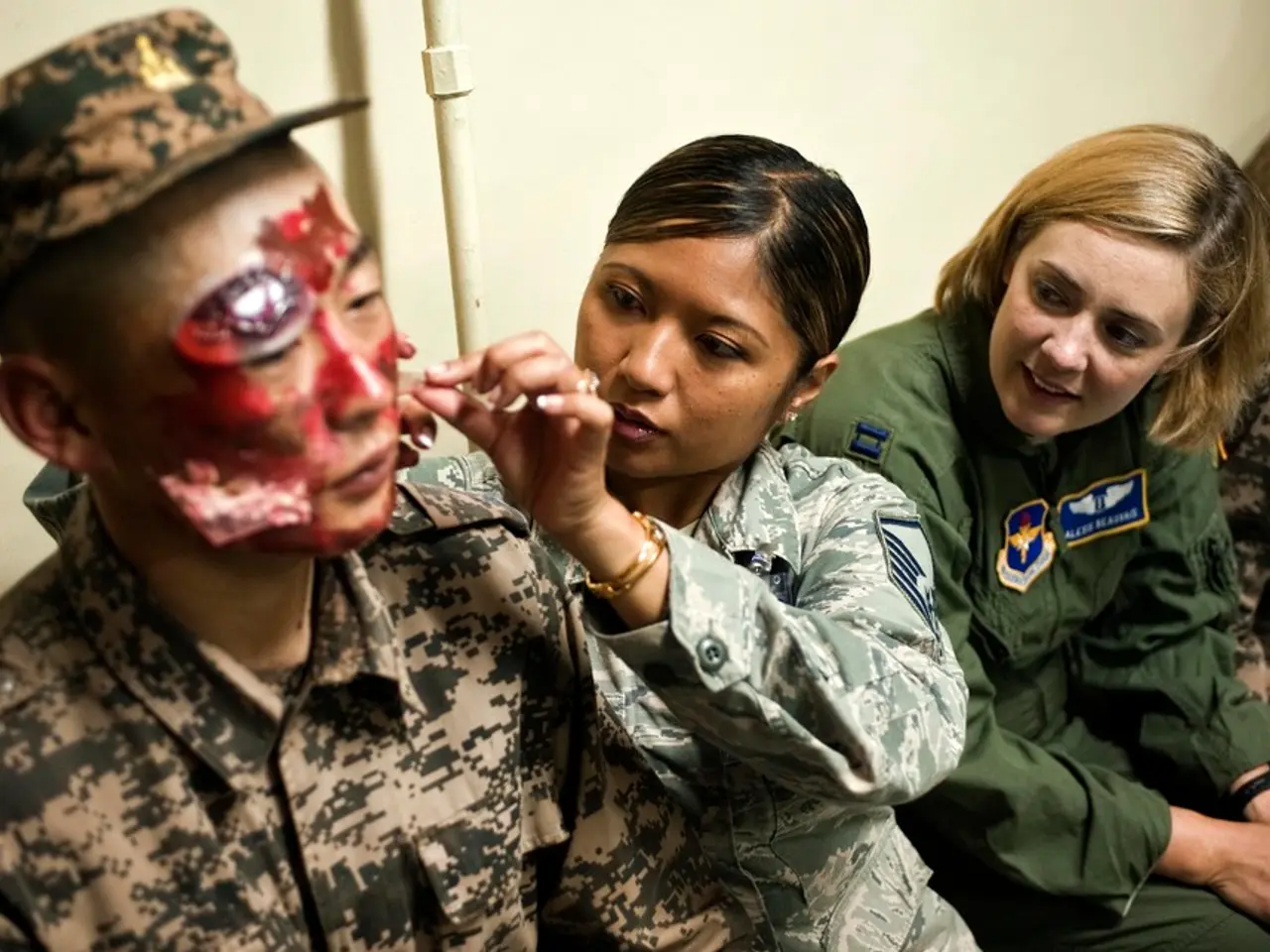Hidradenitis suppurativa complications: Scars and additional issues to consider
Managing Hidradenitis Suppurativa: Prevention, Treatment, and Support
Hidradenitis Suppurativa (HS) is a chronic, inflammatory skin condition that causes the formation of deep boils, lesions, or abscesses on the skin. In this article, we will discuss the key preventive measures, treatment options, and emotional support for people living with HS.
Prevention and Lifestyle Changes
To prevent complications of HS such as infections, scarring, and social isolation, effective management involves lifestyle modifications, early treatment, and appropriate skin care. Maintaining a healthy weight and quitting smoking, as obesity and smoking worsen HS flare-ups, are crucial preventive measures [1][3].
Avoiding skin trauma by not shaving affected areas (consider laser hair removal instead) and wearing loose clothing to reduce friction can also help prevent new lesions [1][3]. Keeping the skin clean with gentle antiseptic or antimicrobial washes, while avoiding harsh scrubbing that can trigger flares, helps reduce infections [5]. Exercising regularly in ways that minimize overheating and sweating (like swimming or exercising in cool environments) supports overall health without provoking HS [1][5].
Early Medical Treatment
Early medical treatment guided by a dermatologist—ranging from topical antibiotics and antiseptics to advanced pharmacologic therapies and surgery—can control symptoms, reduce inflammation, prevent progression, and minimize scarring [3][4][5].
Emotional and Social Support
Addressing the emotional and social impact of HS is also vital. Support from healthcare providers and patient communities helps reduce social isolation and improves quality of life [2]. Early diagnosis and intervention provide a "therapeutic window" for better outcomes and fewer complications [4].
Possible Complications
People with HS are at higher risk of developing skin infections, such as cellulitis [6]. Lymphedema, a condition where lymphatic fluid builds up in the body, is one possible complication of HS [7]. In addition, males who have had lesions around their genitals for years and people who have had HS for a number of years are at a higher risk of developing squamous cell carcinoma, a type of skin cancer [8].
Squamous Cell Carcinoma
Squamous cell carcinoma can present in various ways, including as a horn-like shape, a rough, reddish patch, an open sore in an old scar, a wart-like growth, a dome-shaped growth, or an open sore with raised borders [9]. Squamous cell carcinoma at the mucous membranes, such as those in the anogenital region, can present an additional risk [10].
Conclusion
In summary, prevention centers on lifestyle changes (weight loss, smoking cessation, gentle skin care), avoiding triggers (heat, friction, shaving), early and appropriate treatment, and psychosocial support to manage both physical and emotional aspects of HS [1][2][3][4][5]. Regular check-ups with a healthcare provider and adherence to a treatment plan can help manage the condition effectively and improve the overall quality of life for those living with HS.
References:
[1] American Academy of Dermatology. (2020). Hidradenitis Suppurativa. [online] Available at: https://www.aad.org/public/diseases/hidradenitis-suppurativa
[2] National Institute of Arthritis and Musculoskeletal and Skin Diseases. (2019). Hidradenitis Suppurativa. [online] Available at: https://www.niams.nih.gov/health-topics/hidradenitis-suppurativa
[3] European Academy of Dermatology and Venereology. (2017). Hidradenitis Suppurativa: Diagnosis and Management. [online] Available at: https://www.ncbi.nlm.nih.gov/pmc/articles/PMC5697178/
[4] International League of Dermatological Societies. (2018). Hidradenitis Suppurativa. [online] Available at: https://www.ilads.org/patients/conditions/hidradenitis-suppurativa/
[5] National Eczema Association. (2020). Hidradenitis Suppurativa. [online] Available at: https://nationaleczema.org/eczema/hidradenitis-suppurativa/
[6] National Institute of Allergy and Infectious Diseases. (2020). Cellulitis. [online] Available at: https://www.niaid.nih.gov/diseases-conditions/cellulitis
[7] Lymphoedema Support Network. (2020). Lymphoedema. [online] Available at: https://www.lymphoedema.org/lymphoedema/what-is-lymphoedema/
[8] American Cancer Society. (2020). Squamous Cell Skin Cancer. [online] Available at: https://www.cancer.org/cancer/skin-cancer-squamous-cell/about/risk-factors-and-prevention.html
[9] American Cancer Society. (2020). Squamous Cell Skin Cancer. [online] Available at: https://www.cancer.org/cancer/skin-cancer-squamous-cell/detection-diagnosis-staging/diagnosis.html
[10] American Cancer Society. (2020). Squamous Cell Skin Cancer. [online] Available at: https://www.cancer.org/cancer/skin-cancer-squamous-cell/treatment/treating-squamous-cell-skin-cancer.html
Regular skin care is an essential part of HS management, which involves using gentle antiseptic or antimicrobial washes to prevent infections and avoid harsh scrubbing that can trigger flares [5]. The list of medical conditions associated with HS is lengthy, including chronic diseases and skin-care related complications like scarring [1][3]. Seeking emotional support from healthcare providers and patient communities can significantly improve the quality of life for individuals with HS [2].




